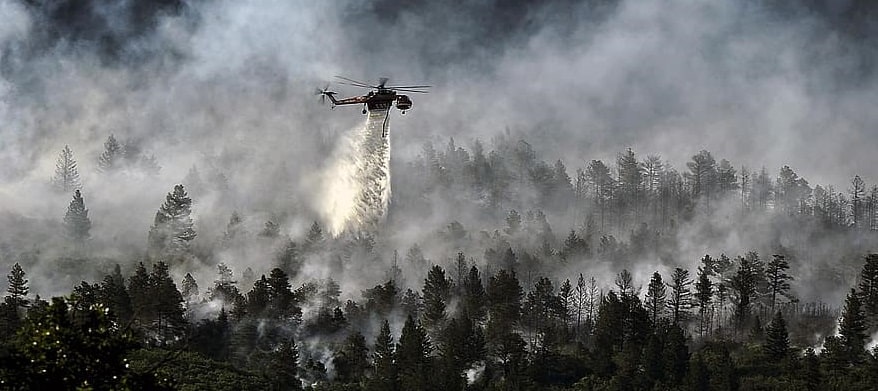
As each year passes we are beginning to see more and more wildfires appearing across the globe with an increase in their size and severity. Many times we see on the news the planes and helicopters dropping white and red fluid on the fires, but what are they? Why do they seem to use different colored fluids?
Water, retardant, gels & foams are the main agents used by aircraft to help cool, contain, & fight wildfires. Red retardant is a salt, clay, & gum-based fluid that sticks to foliage and prevents it from burning. Dropping of water is used to cool areas to slow or suppress the fire’s progress.
When fires become large it is impossible for aircraft and firefighters to extinguish them, we have to let mother nature do that. But, when a fire first develops or is small in nature, air attack of the fire and help from the ground can get the fire out.
To help fight a wildfire there are multiple techniques and suppressing agents that are used and this article is written to hopefully provide you with some insight into what we use and how we apply them.
What Do Aircraft Drop Onto A Wildfire?
We have all seen the news footage of aircraft dive-bombing a wildfire and releasing its load onto it, but what exactly is in those loads, and what is their purpose?
Water
This is the main suppression liquid used by helicopters on a wildfire. One of the first things the helicopter pilots will do is find a water source near the area of the fire they are working. This is referred to as The Dip Site.
Water is used to help cool the edges of fires by using water dropped at speed. This is called a String Drop and it looks like a curtain of water when it is dropped. Or, if there is a particular hot spot that needs an entire drop on it, that is called a Spot Drop.
Water is also used by amphibious water bombers who fly down and essentially land on the water and allow the forward speed to push water through scoops and into the holding tanks. Once the tanks are full the aircraft climb away to dump the water onto the fire.

With numerous helicopters and water bombers working on a fire, a rapid rate of water suppression can be achieved, but water evaporates quickly on hot fires, and if there is no water source nearby it can allow the fire to spread without much effect being taken from each water drop.
Water is also the main agent used to help eradicate any hot spots once the fire has been extinguished. Ground crews will be walking the areas and coordinating with a helicopter pilot to drop a bucket of water onto a certain area as they dig around the ashes.
The main sources of water used by helicopters can be ponds, lakes, rivers, streams, wells, and even swimming pools. The hovering capability along with a water bucket attached to a longline allows helicopter pilots to take on water from some of the tightest locations.
Fixed-wing water bombers however, need long stretches of lake, river or ocean to be able to suck up enough water during their refill runs.
Retardants
When fires are progressing rapidly towards property, livestock or any area that needs protecting the only way to try and stop a fire is to give it a roadblock. These roadblocks can be large rivers, roads, mountain ridges, coastlines, plowed fields, or areas created by fire crews plowing dirt strips or pre-burning areas to remove the fuel.
By taking away the fuel in the path of the fire it stops spreading. This is where liquid retardant comes in. By laying down runs of retardant it can help to steer the fire to a natural fire break or help prevent the fire from jumping a fire break.
Think of retardant as a containment system that is applied by air.
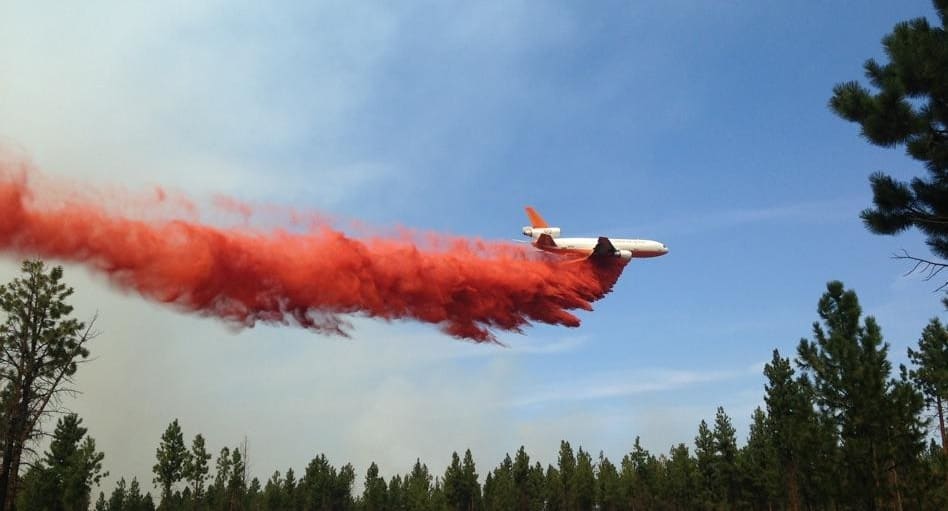
Modern wildfire retardants are a salt, clay/gum-based agent with other proprietary ingredients in them. As the retardant is applied it coats the foliage, timber, and structures preventing them from being ignited. The clay/gum part of the retardant helps the liquid stick or cling and prevents the foliage from becoming exposed over time.
Today’s modern wildfire retardants have been rigorously tested to ensure they are non-toxic to wildlife, foliage, and the environment, the only risk they pose is to aquatic species if applied directly to a water body.
For that reason, retardant is never laid down near watercourses. When it rains, it is washed off the foliage and naturally breaks down in the soil. It is then designed to act as a fertilizer to help fuel natural regrowth.
Retardent comes from the manufacturers as a concentrated liquid and is mixed with water and pumped into the tanks of the air tankers. At many airports that are in wildfire-prone areas, there will be an Air Tanker Base that has purpose-built areas where the mixing and filling of the air tankers happens.
Retardant is mainly applied by the air tankers as they are very good at laying down lines of retardant in large volumes whereas the time it would take for helicopters to do the same job would make it a very inefficient way of fighting a fire.
Retardants are dyed red to help pilots and ground crews see where retardant has been applied. This is especially helpful if numerous tankers are applying retardant along a long line one after another.
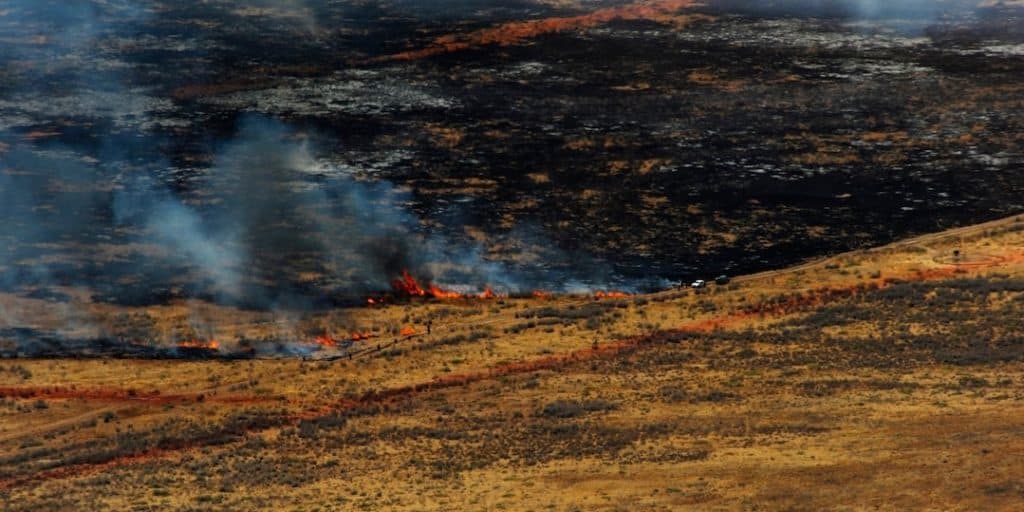
In this photo you can see the lines of red retardant laid down after the road to try and prevent this grass fire from jumping the road and continuing on.
On a small fire I was working this summer, 2 air tankers formed a box around the fire while myself and 2 other helicopters with ground crews onboard flew out. Once we arrived we dropped our crews, put on our water buckets, and worked with the ground crews. Within 2 days the fire was out because it had been contained by the box of retardant.
Gels
Wildfire suppressant gels are another tool in the firefighter’s arsenal. Not typically used as much as a retardant, but a handy product when the right conditions call for it.
Gel is added to water to thicken the water and help it cling to surfaces. The main job of a gel suppression agent is to wrap a cooling blanket of water around a structure to help prevent it from getting ignited by fires burning nearby.
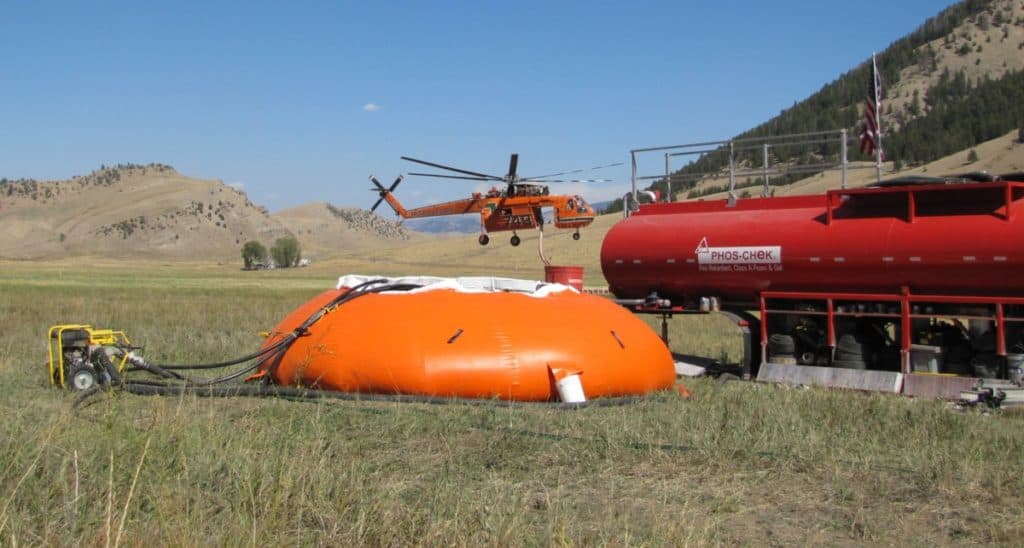
This also comes in a concentrated form and is mixed in holding tanks that helicopters can dip their buckets/snorkels into for precise application to locations like the sides and roofs of particular structures on the edges of a fire.
The other way gel is used is to fill special tanks onboard water bombers with the concentrate mix. As the water bomber scoops up water from a lake it can be automatically mixed with the gel and at release, it is mixed to the correct formulation to allow for large areas to be covered.

Join My Newsletter & Get Great Tips, Information and Experiences To Help You Become a Superb Pilot!
Class A Foams
Foams are a product used to help ‘Mop-up’ after a fire has gone through an area. Just like the retardent and gel, foam comes in a concentrated liquid that is mixed and applied to the area, usually by helicopter or water bombers.
The main job of foam is that it slows the evaporation rate of the water and helps the water to soak into the foliage, timber, or grass allowing for improved resistance to ignition.
As crews and aircraft work to eradicate all the hot spots, water and foam allow the firefighters to work an area and move on knowing that the chances of a hotspot reigniting are very slim. Many wildfires can reappear days, weeks, and even months after the fire was put out because the roots of the trees have been smoldering underground.
The penetrating characteristics of the foam help prevent these smoldering roots from popping up and causing havoc!
What Type Of Aircraft Fight Wildfires?
Some of today’s aircraft that fight wildfires are incredible feats of engineering. Being a pilot of a helicopter on a wildfire can be a very rewarding but tiresome battle with mother nature, trust me, those crews you see are working long, hard, hot days!
Here are some of the common types of aerial application vehicle you may see on a wildfire near you:
Helicopters With Buckets
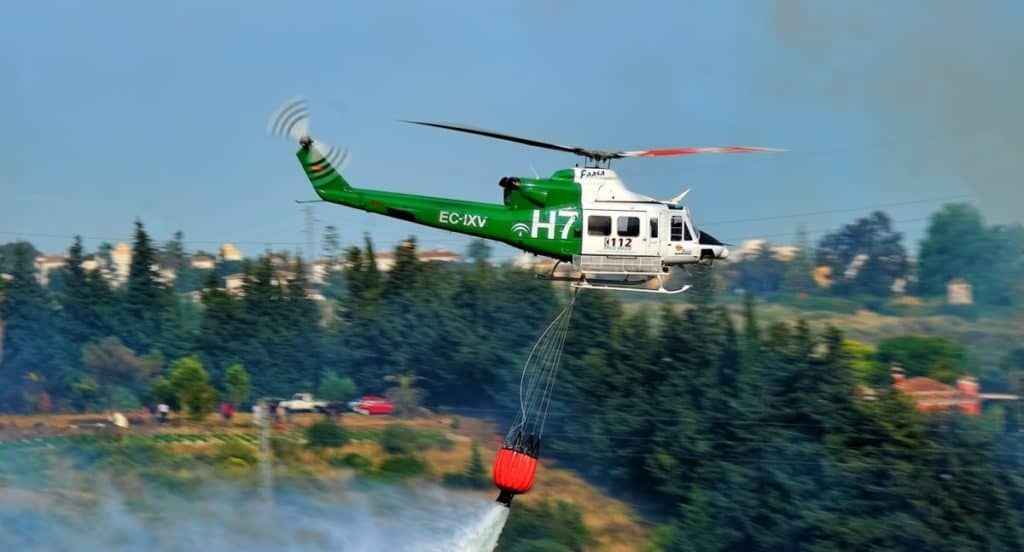
By far the most common wildfire fighting asset. Helicopters can be loaded up with ground crews, sent to the fire, drop the crews off and then join in using a pilot-controlled water bucket.
Helicopters will either operate by having the water bucket connected directly to the belly hook on the helicopter or via a 100-250ft longline.
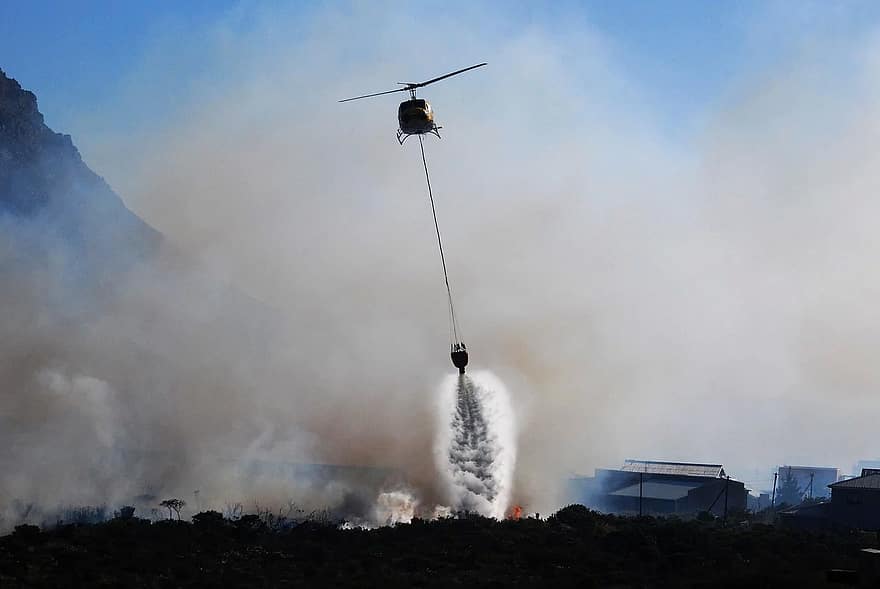
Water buckets work by dipping them into a water source and then at the press of a button from the pilot the bucket can release the entire load or just a partial load.
Water buckets on helicopters allow for fast, accurate placement of suppression agents, but they are limited in the amount of water they can drop. Water buckets range in size from 72gal/270l up to the mighty 2,590gal/9,800l used by the Chinook!
For more information on exactly how a Bambi Bucket works check out this video I created for you:
(17 minutes long)
Helicopters With Tanks
Helicopters can be fitted with a tank that allows water to be sucked up and filled through a snorkel. The tanks allow for large volumes of water to be carried by the larger helicopters with fast turnaround times.
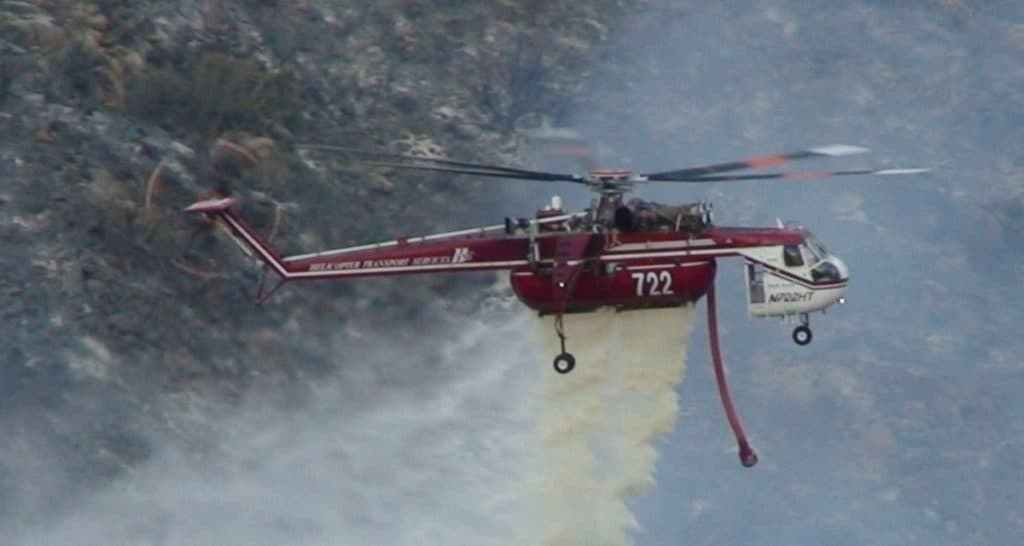
The tank of the Sikorsky S64 is 2,650gal/10,000l and can be filled in under a minute by the hydraulically driven suction pump mounted at the end of the helicopter’s snorkel.
The tank usually consists of doors that open on the bottom to allow the suppression agent to be released and by adjusting the amount of time the doors are open or how much the doors open the pilot is able to control the amount of water dropped on a given area.
This controllability gives the ground coordinators options for long lines of suppression or spot drops to be completed.
The only downside to helicopters fitted with a tank is that they do not carry ground crews so they are not used as initial attack aircraft like the helicopters using buckets. Tanked helicopters can either be single-pilot or dual-pilot crews and will work in conjunction with crews already on the ground.
SEAT – Single Engine Air Tankers
Commonly referred to as ‘Tractors’ these fast, highly maneuverable fixed-wing aircraft allow suppressing agents to be applied to fires in terrain where larger aircraft are unable to get into.
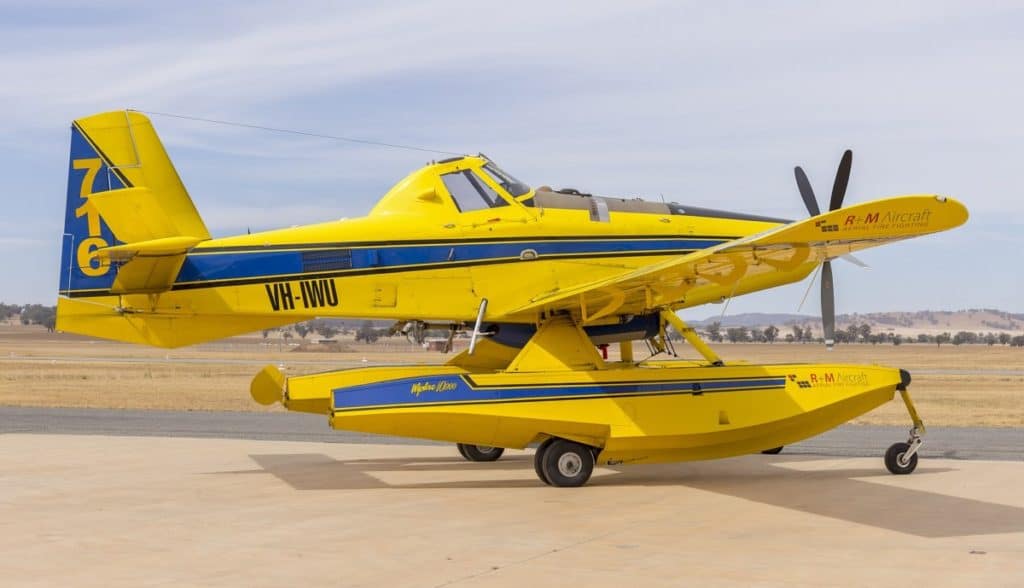
The Air Tractors can either be wheeled and filled up at an airport with water, retardant, gel, or foam or, like the one above, can be installed with amphibious floats that allow them to land on bodies of water and scoop using retractable nozzles on the underside of the floats.
Once they fill their 96gal/364l water tank they lift back into the air and head to the fire. On the belly of the aircraft is a set of doors that act the same as the tanks on helicopters. Controlled by the pilot, they release the agent as a curtain onto the selected area of the fire.
Most of the tractors that I have had the pleasure of working with seem to work in a group of 4-6 all taking turns to scoop and drop. This small team can lay down huge amounts of water onto a fire leaving minimal time in between drops to allow the fire chance to re-establish.
Water Bombers
Water bombers are an Air Tractor on steroids! With multiple engines and usually multiple crew aircraft, these amphibious firefighting aircraft are a common sight on fires all over the world.
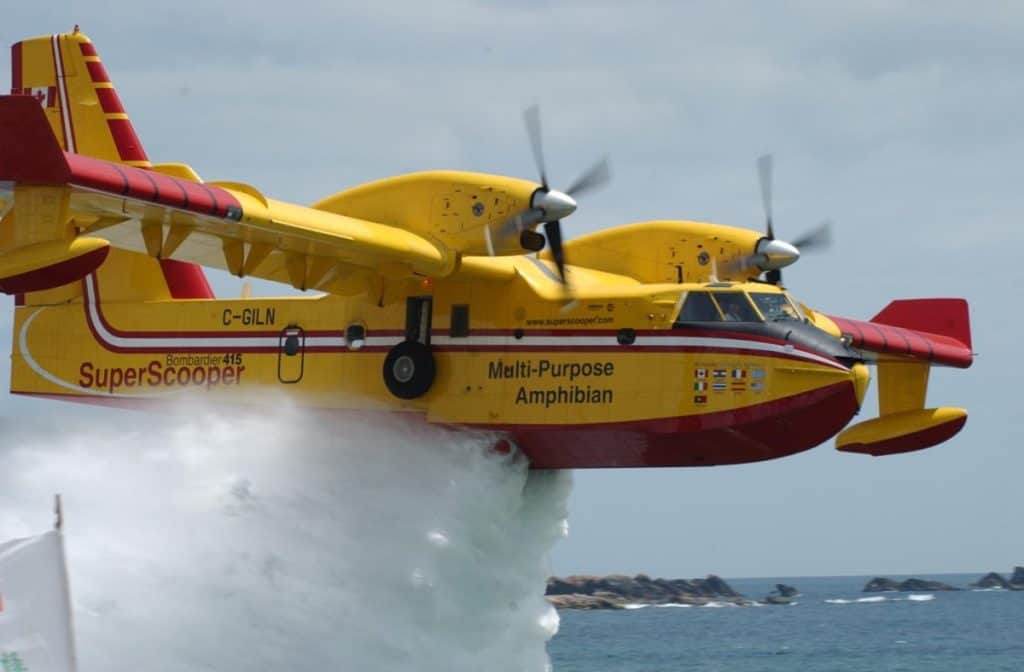
These larger water bombers are usually based at airports all over wildfire country waiting for the call. Just like the Air Tractors, they can be filled up at an airport with water, retardant, gel, or foam, but their main role is scooping water from lakes, rivers, and oceans using retractable nozzles on the underside of the aircraft belly.
Their liquid tank is around 1620gal/6130l and again, is controlled by the pilots to be released from doors also mounted on the belly with an adjustable flow rate.
In Canada, these water bombers tend to work as a pair so while once is scooping water, the other is dropping water. They are very effective!
Air Tankers
If you want to get large volumes of fire-suppressing agents onto the ground then an air tanker is the best option. These converted, ex-airline aircraft have multiple tanks inside them to deliver vast amounts of fluid.
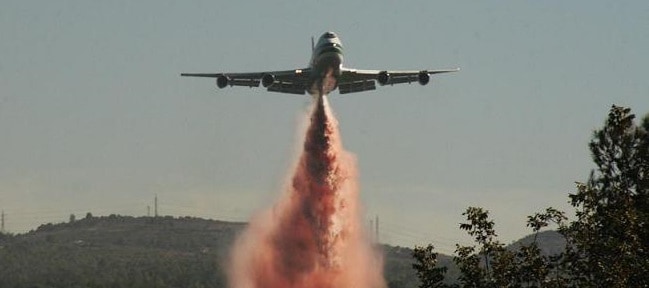
The heavy lifters come in many different forms from C-130 Hercules, L-188 Electra’s, MD DC-10’s with Boeing 747s sitting on the top of the throne! Using multiple engines with multiple crew these large aircraft are the ultimate device for laying down large volumes of suppressant, but once the tanks are empty they have to return to the airport to reload.
Suppressant tanks range in size from 3000gal/11,350l in the smaller air tankers up to a whopping 19,200gal/72,680l in the Boeing 747! All of these tankers have variable drop controllability to allow for very long or high-flow multiple drops to be made.
To Finish
Getting a suppressing agent onto a fire is very easy in today’s world but it comes at a high financial cost. No matter if the aircraft are delivering water, retardant, gels, or foams many aircraft and ground crews are required and if the fire is already large, they are not getting it out without help from mother nature.
Using the suppression agents pilots can help to control the spread or steer fires to areas where they will cause minimal amounts of danger, but unfortunately, no matter how much work the crews put in it can be a devastating experience for those who cannot be protected.
Further Reading
If you found this article interesting and would like to keep reading, I highly recommend the following articles from my blog:

